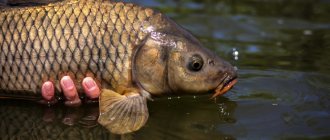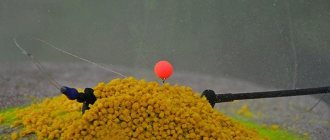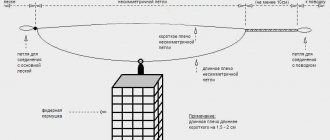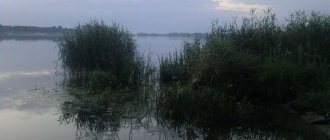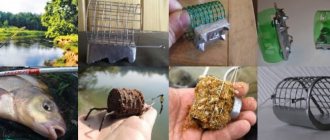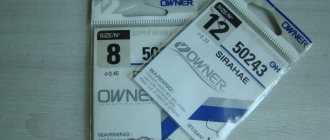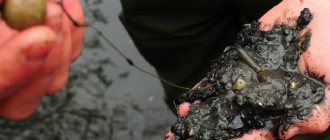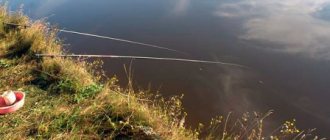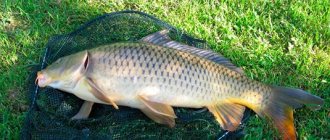Modern fishermen can pick up the necessary equipment for catching any type of fish in a specialized store.
A fairly popular type of fishing today is feeder fishing, which allows you to catch fish at different depths and distances from the coastline.
Fishing with a feeder is a fairly simple process that can be mastered not only by an experienced fisherman, but also by a beginner in the field of fishing.
What is a feeder
A feeder is a type of bottom gear that was invented in England in the 50s. The first fishermen who began to use this gear lived near the Severn River. When developing bottom gear, the main goal was to catch fish at great depths and distances from the shore line. The first fishing rod was made from bamboo by Richard Walker. Gradually the gear was improved. At the same time, lighter materials were used and equipment elements were supplemented.
The basis of the feeder tackle includes:
- coil;
- feeder;
- hooks and leashes;
- rod
In addition, the angler uses the main line, stand and bite alarm.
Feeder fishing spots
Fishing with a feeder is quite exciting and dynamic. When choosing a place for fishing on a feeder, you need to make sure that the area is not snagged. The current should not be strong. Once the casting location has been selected, you can begin mixing the bait.
In order for the purchased bait mixture to reach its proper condition, it must be diluted with water and kept for about 20 minutes. Water is poured into the container with bait in small portions. Homemade bait can be used immediately.
After attaching the sinker to the tackle, you should make the first cast. Taking into account the time of fall and observing the fishing line, you can determine the depth indicator. By pulling, you can determine the topography of the bottom surface, the presence of algae and various obstacles under water that complicate the fishing process.

Experienced fishermen recommend fishing with a feeder in areas with small holes and bumps on the bottom surface. It is in such places that there is a massive accumulation of fish.
Note!
During the fishing process, it is necessary to systematically adjust the equipment: adjust the length of the leashes and change the weight of the feeder, try other hooks.
Feeder tackle
Feeder tackle is characterized by the presence of small guide rings on low holders. In addition, there is a small number of replaceable tips that signal bites and allow you to fish with feeders of different weights.
Feeder tackle is divided into classes:
- easy;
- ultra-light;
- medium (average);
- heavy;
- super heavy.
Most often, anglers use middle-class rods, which impress with their versatility. Such tackle can be adapted for any fishing conditions.
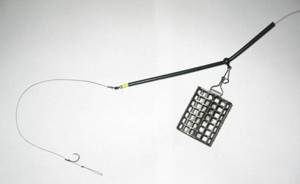
Test
The test should be directly proportional to the class of gear. For example, for the middle class, a rod test in the range of 40-80 g is ideal. For a light class, a weight of 40 g will be enough, but for a heavy class, you will need equipment weighing more than 80 g.
Note!
The upper limit of the dough should not be exceeded.
Length
Feeder tackle consists of several parts. The length of the rod can be in the range of 2-4.5 m. The tip is painted in a bright palette, which allows it to be clearly seen when biting, even from a long distance.
Build
The length and class of gear affects the action. Massive rods with considerable length have an ultra-fast action. Light class gear is equipped with a soft parabolic action.
To perform hooking well, you need a rigid form. That is why most manufacturers produce gear with fast action. It is almost impossible to find a form with a slow action.
Note!
Avid fishermen recommend using feeders 3.6 m long for fishing. The action should be fast.
Reels for feeder tackle
Reels for feeder tackle are used of the inertia-free type or ordinary ones, which are intended for spinning fishing. Such reels are distinguished by the presence of an increased gear ratio.
When choosing, it is important to pay attention to its quality indicator. It is better not to consider Chinese versions of products. The presence of a baitrunner on the product is a definite advantage. Thanks to the presence of a bayrunner, it is possible to achieve an accelerated transition from the operating mode to the minimum friction brake. In this case, the line is released freely.
On each reel you can find the numbers 1000, 2000, 3000, etc. This designation indicates the size of the spool. Various sizes are designed to spool different diameters and lengths of fishing line. For feeders, the universal spool size is considered to be in the range of 2500-3500.
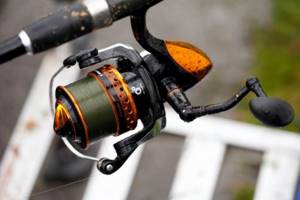
Feeder Accessories
Equipment for feeders can be varied.
The equipment consists of:
- feeders;
- leash with hooks.
Experts identify a number of methods for tying equipment. The most popular ones are described below.
Paternoster
Paternoster is considered the simplest type of equipment. To perform it, the angler needs to tie a small loop at the tip of the main fishing line. A large loop is knitted 13 cm higher into which the feeder can fit. The fishing line must be passed through the rings of the tackle. Using a swivel, the feeder is attached to a large loop. A leash on which the hook is located is attached to a small loop using a swivel.
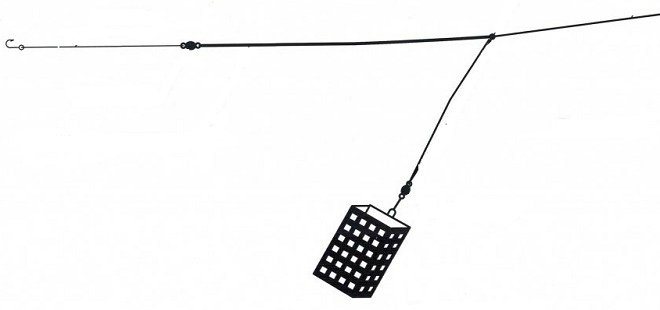
Asymmetrical loop
It is advisable to use an asymmetrical loop for catching bream and carp. It is necessary to put a swivel on a piece of fishing line, onto which the feeder is subsequently fixed. After this, you can proceed to tying a loop, the length of which will reach 50 cm. From this loop, the next loop is formed, the length of which reaches 11 cm. A leash with a hook is attached to the small loop. For this purpose, a loop-to-loop connection is used. The length of the loops is fixed. After tying the knot part, you can begin to connect the rig to the main fishing line. Avid fishermen recommend using a carbine and swivel.
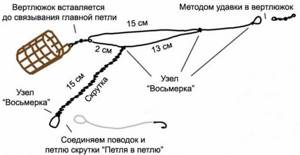
Helicopter
The helicopter is characterized by reduced sensitivity. However, when biting, you can be sure that the fish has already been hooked. A swivel is attached to the fishing line, the length of which reaches 40 cm. To ensure free rotation, you should use silicone stoppers. One extreme part is fixed to the main fishing line using a swivel-carabiner connection. You can attach a leash to the connecting link of the two parts of the mechanism, and a feeder to the free outer part of the fishing line.

With sliding feeder
A rig with a sliding feeder is great for quiet hunting in a body of water with minimal current. A stopper, a carabiner and a second stopper are put on a piece of fishing line, the length of which reaches 70 cm. Loops are constructed on the extreme parts, with which you can fasten the leash and attach it to the fishing line. The feeder will be able to slide freely between the stops.
{banner_vnutri-kontenta-3}
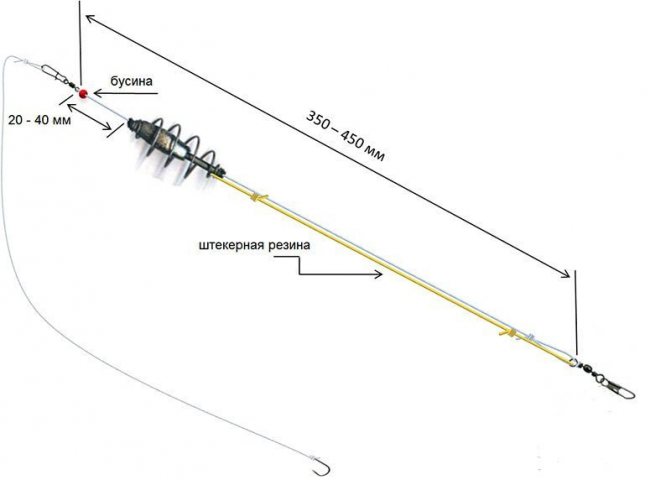
What elements does the feeder consist of?
The configuration of such gear is not very different from spinning gear, but there are differences:
- rod;
- fishing line or cord;
- coil;
- equipment: feeder, weight, leashes, hooks, anti-twisters, stoppers;
- a set of interchangeable tips (quivertips);
- bite alarms;
- accessories for feeder fishing.
Feeder rod
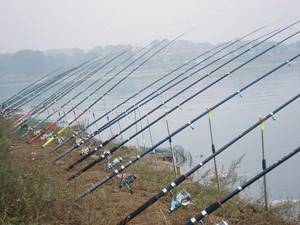
When choosing a fishing rod, a beginner should know its characteristics. This is necessary in order to select the right equipment for certain equipment parameters or vice versa. It is necessary to choose tackle taking into account the material from which it is made, test, action, length and quivertypes.
Material
Carbon (carbon fiber), fiberglass or composite materials are used to make blanks for feeder gear.
Fiberglass material is characterized by good flexibility and elasticity. Fiberglass blanks are a budget option and have a low price. The disadvantage is the heavy weight.
Carbon material is lighter in weight, has a high level of strength and flexibility, and can withstand heavy loads when playing fish. The main disadvantages are its high price and the fragility of the material in places exposed to impacts. These blanks can easily withstand the bending load that occurs when the fish jerks. But they can break in the place where there was a previous blow, for example, with a sinker or on a stone.
Always place the tackle on a stand. You can damage the form by stepping on it or hitting it against a rock. Try not to hit the form with a sinker or feeder.
A composite rod has some of the characteristics of both fiberglass and carbon. It is less fragile than carbon fiber and lighter than fiberglass. This is a universal and ideal option for a beginner.
Test
The choice of the test depends on the weight of equipment that will be used.
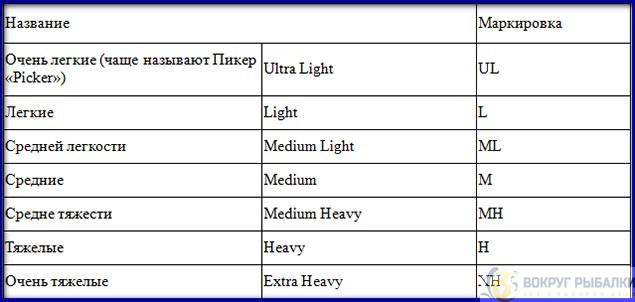
The choice of spinning test depends on the fishing location. In shallow areas or a quiet river, a rod with light to medium light dough will do. At greater depths or currents, it is recommended to use “sticks” with medium or medium-heavy dough.
Rod length

The casting distance and the convenience of landing fish depend on this indicator. Blanks are available in lengths from 1.6 m to 4.5 m. Long bits are good because they are capable of casting over a considerable distance. These are rods with a length of 2.4 m. With such gear it is easy to control the landing of fish, but they are less compact and have significant weight. They can be used in coastal areas where there is no vegetation or objects that interfere with the swing.
For fishing from a shore planted with plants or a boat, the desired gear size is up to 2.1 m.
For beginner fishermen, tackle lengths from 1.8 m to 2.4 m are suitable for training.
Quiver Tips
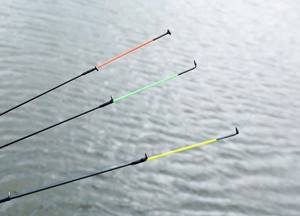
The replaceable tip of the feeder tackle, which serves as a bite alarm, is called a quivertip. Tips (usually 3–5 pieces) are included in the rod kit. They are characterized by different hardness (test) and are installed on the rod depending on the weight of the equipment filled with bait. The test may be expressed in grams or English ounces (Oz). The ratio of one ounce to grams is 1 to 28.3. The smaller the quivertype test, the more sensitive it is to fish bite. Budget feeder kits only include 1, 2, and 3 ounce extra tips. The more expensive ones also have 4 and 5 ounce tips.
Build
The action of a fishing rod is an indicator of its rigidity and elasticity. The speed of flexion and extension of the bit when casting the equipment depends on elasticity. This affects such characteristics as sensitivity, range, swing size.
The structure is divided into categories:
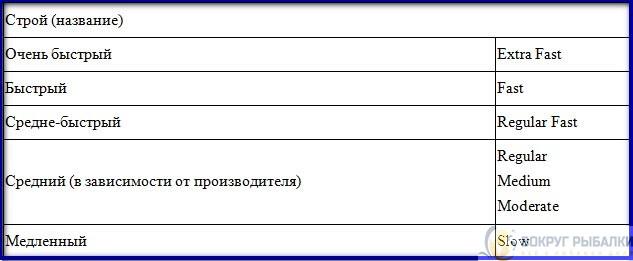
Very fast and fast action is most popular. The rods have high rigidity, only the tip is bent. To cast you need a small swing. They have high accuracy and sensitivity. The disadvantages include the short casting range.
Slow tuning has the opposite characteristics to fast tuning. It is very soft and when fishing for a large specimen it can bend into a parabola. Such tackle can make long casts, but the sensitivity is weak and accuracy is not guaranteed.
Medium-fast is a combination of fast and slow tunings. Everything here has average indicators: range, sensitivity, accuracy, elasticity, rigidity.
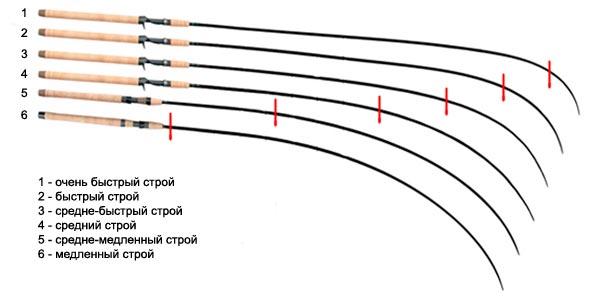
For a novice feeder, it is recommended to start with “sticks” that have a very fast or fast action.
Reels
Fishing with a feeder requires a spinning reel with a rear friction brake. An important indicator of a reel is the gear ratio, as a result of which the reel can be either power or high-speed. Reels with gear ratios up to 4.6–5 are power. If the number is 5 or more, then this is a high-speed reel. For feeder fishing, it is recommended to choose a spinning reel with an average gear ratio of 4.8 to 5.5. The optimal spool size will be from 2,500 to 3,500.
For a beginner, it is recommended to buy a “MATCH” type reel with a baitrunner system and a set of spare spools, which allows you to use fishing lines of different sections ready for installation.
The baitrunner system is necessary in order not to miss the big fish. The baitrunner design instantly sets the friction brake to its minimum operating state, as a result of which the line comes off the spool with little resistance. This allows you not to miss the fish and does not give it the opportunity to drag the fishing rod into the pond.
When purchasing a reel, check for any play, rust, mechanical damage and the possibility of reinstalling the handle under the “working” hand.
Equipment
The main function of the feeder equipment is to directly transfer the bite from the leash to the tip of the tackle without interference from the feeder.
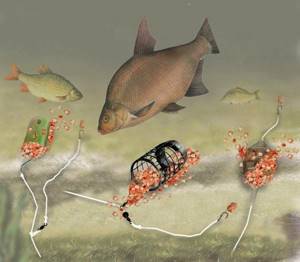
For this purpose, several options for installing its elements have been developed:
Paternoster
Manufacturing is carried out on the main line in two ways:
- In the first option, a loop measuring 3–4 cm is knitted at the end of the fishing line. Another loop, measuring 5–8 cm in size, is knitted 25–30 cm higher on the main fishing line. A leash is inserted into the small loop, and a feeder is attached to the large loop.
- In the second option, a loop is made on the main line, 20–25 cm long. The loop is cut in a ratio of 1 to 2. Both ends are equipped with swivels. A leash is attached to the long end, and a feeder to the short end.
Symmetrical loop
One meter of fishing line needs to be folded in half, resulting in a loop of 50 cm. A small loop, 3–4 cm in size, is made at the bend. A swivel with a carabiner is inserted into the free fishing line. At both ends of the large loop, knots are tied at a distance of 10–15 cm, between which there is a swivel with a feeder. The leash is inserted into a small loop, the other end is attached to the main fishing line.
Asymmetrical loop
We tie one and a half meters of fishing line into a ring, having previously inserted a swivel into it. On one side we retreat 50–60 cm and make a twist-out 10–15 cm long, with a loop at the end. A leash is inserted into the loop. The second asymmetrical part of the fishing line will be 70–80 cm. The feeder is attached to it.
Anti-twist tube
A lower swivel is put on a fishing line 0.5 meters long, and a stop bead is installed above. We pull the fishing line through the anti-twist tube. An upper swivel is installed on the second end and attached to the main fishing line. A leash is inserted into the lower swivel.
Sliding feeder
A fishing line 0.6–0.7 meters long is used. A loop measuring 3–4 cm is made from the lower end, onto which a stop bead is installed. After this, a carabiner for feeding or a springy feeder with a hollow tube inside is put on the fishing line. At the other end, another loop is made, onto which a stop bead is installed. A leash is inserted into the lower loop, the upper loop is attached to the main fishing line.
To collect the equipment you will need: main fishing line, leader material, feeders and sinkers, hooks.
All accessories are discussed in detail in the next article ▶.
Main line and braid
As the main line, you can use braided or monofilament. Each of them has its own advantages and disadvantages.
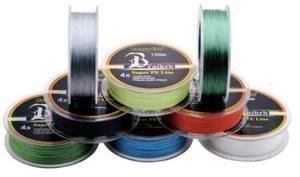
It is not recommended to use monofilament if you need to cast equipment over a long distance. The diameter of the fishing line is always larger than the braid, and accordingly, its windage is higher, as a result of which the casting distance is reduced. The monofilament has a high degree of stretch, which has a very negative effect on the sensitivity of the gear, this becomes especially noticeable when fishing in the current. Monofilament is used for light and medium types of bits. For the light type, a cross-section of 0.12–0.18 mm is recommended, and for the medium type – 0.16–0.22 mm. This size is enough for a “teapot” who wants to fish for a good specimen. Using a large cross section is impractical.
The braided line is highly sensitive even at very long distances. This is achieved due to the lack of stretchability of the cord. A slight bite is immediately transmitted to the tip of the feeder. This line is installed on all types of feeders. Recommended cross-section is 0.18–0.22 mm. This allows you to catch fish weighing up to 6–8 kg. The disadvantage of braided fabric is its sensitivity to mechanical damage. It may break during fishing when caught on a sharp stone or shell.
For a novice amateur, it is recommended to pay attention to a special feeder line.
Leashes and leash materials
For leashes, it is recommended to use high-quality fishing line or special leash material. The most popular is a fluorocarbon leader. It has a significant tensile strength and is invisible in the water.
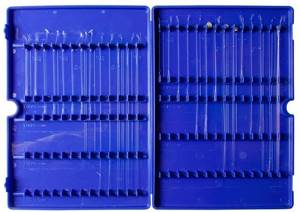
It is recommended to have interchangeable leashes of different lengths, from 20 to 50 cm. The presence of a leash of a certain length depends on the intensity of the bite. The worse the bite, the longer the leash needs to be installed. To transport leashes, there is a special leash box where you can put them. An experienced fisherman carries with him leashes of different lengths and cross-sections, with different sizes of hooks. Having such a reserve saves time when re-equipping equipment.
Hooks
The hook is selected depending on the size of the fish and bait, and the time of year. For feeder fishing, international type hooks from No. 10 to No. 18 are used.
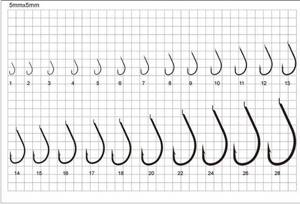
The thinness or thickness of the hook depends on the bait. For animal bait (worms, bloodworms, maggots), you need to install thin hooks. Then the bait will be viable longer. For bait of plant origin, the thickness of the hook is not very important.
There are several ways to check the sharpness of a hook. You need to run it with the tip along the nail. The presence of hooks indicates that it is sharp and can be used for fishing. You can also use a hook to pierce a maggot. If the maggot is easily pierced with a slight touch, then such hooks are suitable for use.
If the hook becomes dull, it can be sharpened on any smooth stone.
Feeders and sinkers
The feeder is designed to deliver bait mixture to a certain point, lure fish and hold them
To achieve the desired effect, there are different types of feeders:
- for starter feeding;
- for long casting;
- supplementary feeding for calm water;
- supplementary feeding for flow;
- for live food;
- method feeders.
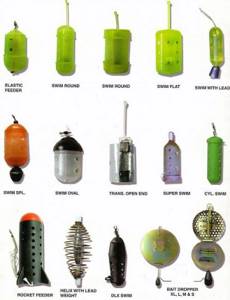
The feeder for starter feeding has a mesh with large cells, which allows the feed to quickly fall out of the feeder and quickly create a bait spot.
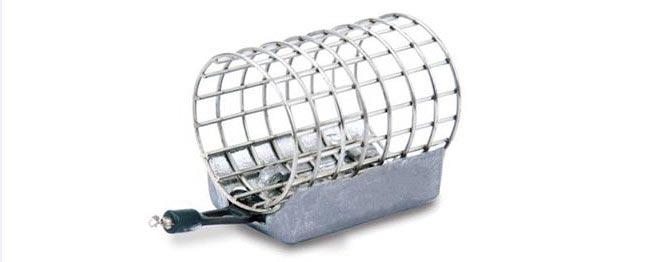
into the feed for long-range casting . It has a badminton shuttlecock configuration and a casting range up to 40% greater than that of a regular cormak.

Supplementary feeding feeds for calm water have different shapes. It is not fundamental, since the main task of the design is to deliver an additional portion of complementary food to the fishing point and retain the fish there.
Supplementary feeding feeds for currents are made with a fine mesh and a loaded bottom. The weight holds the food in place, and the small cell prevents the food from being washed out quickly.
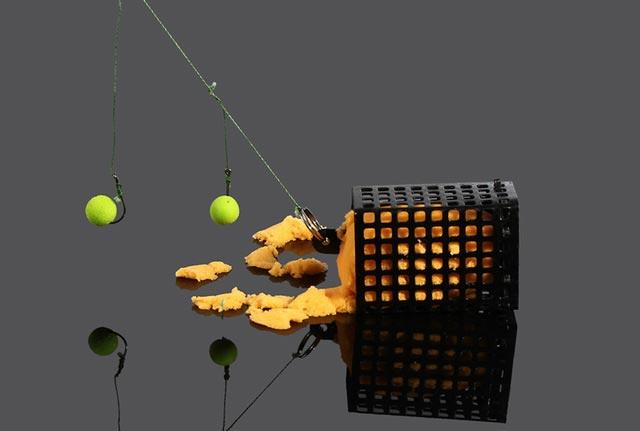
The feeder for live food has the shape of a balloon with small holes. This device is used when it is ineffective to constantly add live food to the bait. Cormac holds the crawling food at the fishing point for a long time.
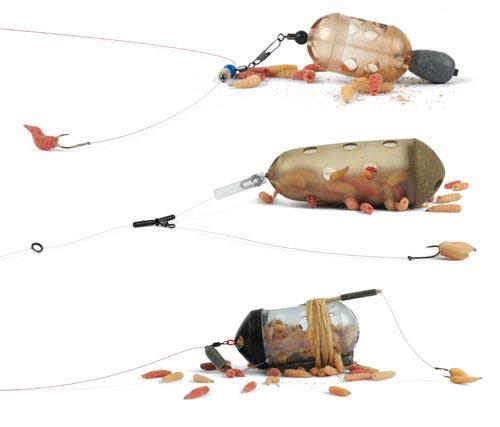
Flat method feeders
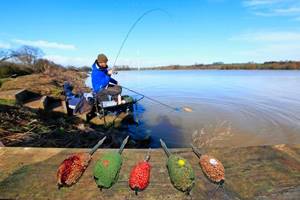
Accessories required for feeder fishing
This set includes:
- fishing rod stand;
- bite alarm. The indicator can be ordinary (simple weight), sound (bell), light (with sound), quivertype;
- container for feeding. Any wide container in which complementary foods can be easily mixed will do, and a sieve is a must;
- fish tank. Must ensure the viability and comfortable position of fish in the water;
- landing net for fish. It should have a handle of medium length and an area that allows you to freely pick up fish in the water.
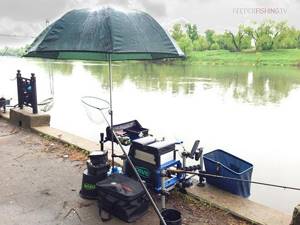
Feeders
For feeders, it is recommended to use feeders that are made from various materials. Metal and plastic products are available for sale. The latter are able to rise well from the bottom surface. The likelihood of snags in this case is minimal. It is advisable to use plastic feeders when fishing snagged areas of a reservoir.
The feeders available for sale are:
- spring;
- frame;
- in the form of a grid.
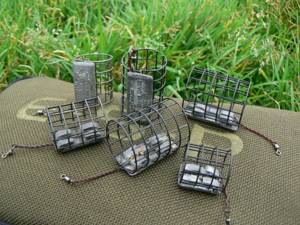
The spring type of feeder is a hollow tube around which a wire is twisted like a spiral. The line passing through the tube allows the feeder to slide easily in the area located between the stopper and the swivel. The spring type of the product has excellent flight characteristics. For fishing in an area with a current, a spring feeder is not suitable.
The frame type has similar features to the spring type. Instead of a spiral, there are plastic blades along the entire length of the tube. The bait mixture for such products should be viscous.
Mesh feeders are often called cages. They can be of various shapes, weights and sizes.
The manufacturer produces different types of sections:
- round;
- square;
- in the form of a semicircle;
- rectangular;
- triangular.
When fishing standing areas of the river, it is advisable to use round feeders. The remaining types of sections are intended for quiet hunting in places with strong currents.
Selection of equipment
Equipment or feeder installation can be called everything that we attach to the main fishing line.
Its main purpose is to place the hook in the right place and provide a signal from the fish's jerks. The hook is the most important part of the tackle. There is no way to save on this part of the equipment. You need to choose the best hooks available to you. It is with the hook that we catch fish. It depends on him whether she leaves or not. The size, thickness and depth depend on the bait used and are independent of the size of the fish you intend to catch.
Leash. The larger the fish, the more shy it is. After all, she grew to such a size thanks to her intelligence and caution. Even if such a fish takes the bait, then, feeling resistance from the leash, it can immediately spit it out.
The feeder must match the strength of the current and the required casting distance. On a strong current in a large river, it is necessary to use feeders weighing up to 150 g. This way you will ensure the fastest immersion in the water and fishing approximately at the point where the feeder splashed down. In standing water there is no need to use feeders heavier than 30g.
The best feeding troughs are the open type. For standing water, you can use any shape, but in a current it is better for the bottom of the feeder to be flat rather than round. This will ensure reliable grip on the ground.
The selection and construction of rigs is described in our popular guide to feeder rigs.
Bite alarms
Bite alarms for feeders are made on the basis of fiberglass and carbon fiber. Soft quivertypes made of glass composite (translated as a fluttering tip) with a test value of 0.5-2.5 are advisable to use when fishing stagnant areas of a reservoir.
For feeder fishing in the current, it is necessary to use alarms made on the basis of carbon fiber with a test of 3-5 oz.
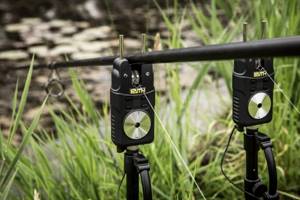
Feeder
The feeder feeder has one task: to deliver the prepared bait to the fishing sector, to allow it to fully open, attract fish and keep it at a given point. They can be square, round, oval, with or without additional weight.
There are several types of feeders for feeder rods:
- starting feeding;
- long cast;
- Still water;
- supplementary feeding during the flow.
Feeder designed for starter feeding
It differs from others in the size and dimension of the cells. Her kormacs are decent and open, the mesh is large. The bait from such a feeder should be washed out quickly; it is used when it is not possible to throw the bait by hand.
If such a feeder hits the bottom, it is necessary to carry out a sharp hook. It will quickly clean itself and be ready for the next cast. They need to be done several times, from 5 to 10.
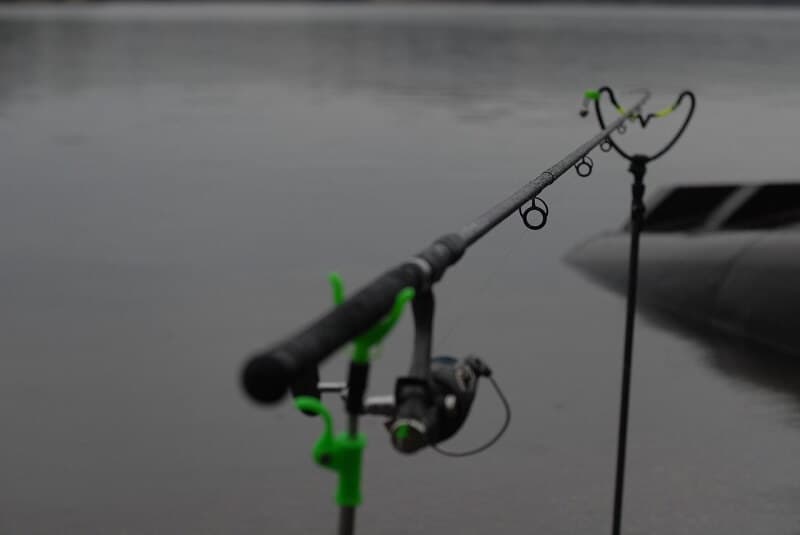
Feeder for fishing in still water (pre-feeding)
As a rule, this is exactly the same as the previous one, only smaller in size. The main element here is the cells; the bait should be gradually washed out and keep the fish in a given sector. It doesn’t matter what shape it will be.
Feeder for supplementary feeding during the current
The most important thing here is the form. The mesh is small, the feeders are flat, and the bottom is weighted. Both a fully closed cell and a half closed cell can be used. Its purpose is to keep the bait in a given area.
Long cast feeder
It looks like a badminton shuttlecock. A ball-shaped weight is attached to one part of the feeder (front shipment), followed by a round feeder. When cast, it behaves exactly the same as a shuttlecock. Thanks to this, it can be thrown 25, 30% further, unlike a regular one, which has a similar weight.
Feeder baits
To catch peaceful and predatory fish on a feeder, you will need to select a suitable bait.
Among the universal baits for the feeder are:
- maggot;
- earthworms;
- barley;
- caddis larva;
- corn and boilies.
Experts recommend choosing bulky bait for catching large fish. Boilies, which are available in a wide range in a specialized store, are perfect for this purpose.
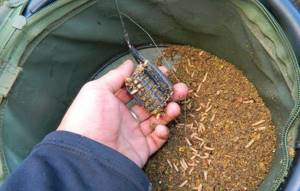
Lure
Specialized stores sell bait for specific types of fish. Experienced fishermen prepare their own bait.

It is based on 3 components:
- The basis. Inexpensive ingredients that are attractive to fish. They use cake, bran, mixed feed, millet, and crackers.
- Food supply. “Sweets” are placed in the feeder to satisfy the gastronomic preferences of the fish. Bloodworms, worms, boiled corn, pearl barley, peas. The choice is based on knowledge gained through practical experience.
- Additives attract fish from all corners of the reservoir. Fish of the carp family like the smell of anise. Proven flavors include honey and garlic, gingerbread and sunflower.
The effectiveness of bait is determined after “shelling” sections of the reservoir with feeders filled with food components of different combinations.
What kind of fish can you catch on a feeder?
You can catch a variety of fish on the feeder, namely:
- roach;
- carp;
- crucian carp;
- carp;
- tench;
- roach;
- catfish, etc.
Bream is a cautious fish that can even be spooked by gear. Fishing for bream on a feeder occurs on heavy feeders with a lead bottom, which do not move from their place with water flow.
To catch roach, you need to cast away from the feeding area. Gradually the bait is pulled to the desired point. The roach is quite shy, so when casting into the feeding area, it will most likely leave the unsafe place.
Fishing for crucian carp with a feeder occurs at shallow depths near the shore. It is first necessary to examine the bottom surface. It is better to avoid heavily corroded areas of the reservoir. After all, it is in such areas that accidents occur during fishing.
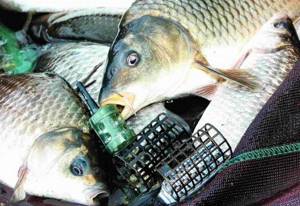
As bait you should use maggots, worms or pearl barley, this is how carp are caught on a feeder, but you can offer them as bait:
- insects;
- boilies;
- earthworm;
- shellfish
Fishing with a feeder from a boat
To fish on a feeder from a boat, you need to select a point and successfully anchor. Only after this can you proceed to the starting feeding of the area.
Note!
The bait mixture is prepared in advance on the shore so as not to create additional noise on the boat that scares away the fish.
The tackle is equipped with a volumetric feeder. The measured length of the fishing line is fixed with a clip, which helps the bait ball to accurately hit one point.
For starter feeding, it is enough to add a third of the finished mixture. The rest of the feed is thrown in every 10-15 minutes during the process of catching fish on the feeder. After installing a small feeder on the feeder, you need to begin installing the leash with a hook. Having planted the bait, the fisherman proceeds to filling the feeder with the bait mixture. Having completed an accurate cast, the tackle is installed on board.
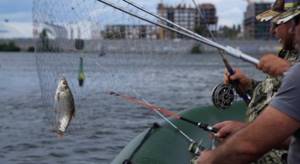
The process of fishing from a floating craft is difficult, because the fisherman cannot find a reliable foothold on the boat. Large carp or carp often take advantage of the resulting slack in the fishing line and get off the hook. When fishing for a large trophy, it is better to let it get tired at a great distance from the boat and only after weakening its resistance, speed up the process of bringing it into the landing net.
Fishing with a feeder is an exciting process that not only brings pleasure to the fisherman, but also provides him with a decent catch. If there are no bites for an hour, you should move to another place or use other baits. Using various devices and going fishing in different bodies of water, you can quickly learn the tricks of feeder fishing.
Feeder for beginners from A to Z.
Mistake #3 – Fishing without using a clip.
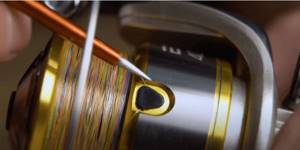
And this will be the third and I would say the main mistake in feeder fishing is fishing without a clip. You can see how to clip the distance below in detail:

What is the essence of this mistake: Fishing where “God sends” takes place in the feeder, when we catch crucian carp in reservoirs where there are a lot of trash fish (small roach, rudd). And creating a point is dangerous because you can collect a lot of these fish with complementary food, which will constantly eat our bait. In all other cases, the more dense and crowded the fishing and feeding point you have, the more intense and active the bites will be.
This is one of the main components in feeder fishing. And the so-called “school of a drunken master” works, but very, very rarely.
Mistake #4 – Fishing without starting feed.
Starter feeding is also not an unimportant fact. Why do you need to feed the fish from the start? 1) You increase the concentration of fish at your distance. 2) Increase the size of the fish. Just like how fish come to eat, different ones, both small and big. 3) And the most important thing is that you collect fish much faster.
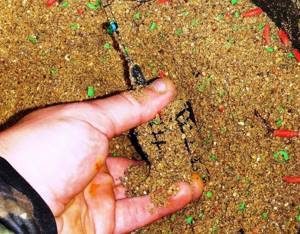
It’s better to feed from the start than to re-feed at some intervals (even quickly). Don’t make the common mistake of finding a point and immediately starting to fish. It’s better to feed at least 5, or better yet 10, or even better, 15 feeders to this point and believe me, you will feel the difference! Feeder fishing loves this method of fishing!
